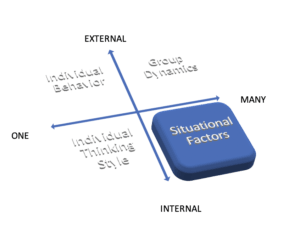Facilitators must understand and manage meeting conflicts. Therefore, we must first understand our own internal conflict so that we are prepared to serve others. Critically, we should view our meeting conflict response as both a challenge and an opportunity.
Meetings are expensive and mitigating conflict provides one of the absolute best reasons for meetings. However, conflict also comes from the situation, and from you.
Don’t Run from Internal Conflict
Internal conflict is fear, and all people have fears. However, when we allow these fears to control us, we lose our ability to perform. Therefore, the first step is to understand our fears. Once we do, we can control them and begin to manage conflict. Because fears never go away—you simply learn to acknowledge or contain them. Learn to control fears. Below are some typical facilitator fears:
- Being too “mechanical”
- Challenges and attacks
- How much responsibility to take
- Inability to persuade, motivate
- Looking like a beginner
- Losing control — asserting control
- Making mistakes or failing
- People with problems
- Public speaking
- The unknown
- Wanting to be liked, approved of
- Wanting to give advice or ideas
- What to do about silence
Fly In Formation
Once you identify your personal fears, you can find ways to make them work to your advantage. Remember that the butterflies in your stomach will always be there. Therefore, you don’t want to remove them. However, you want to teach them to fly in formation.
External Conflict
Conflict in your group is natural and not necessarily bad when responsibly managed. Hence, you must channel conflict into productivity. Managed well, conflict leads to expanded information exchange, surfaced rationales, more options, and better group decisions that enable change. Managed poorly, conflict destroys. Effectively managed, conflict leads to positive transformation. However, if left festering in the hallways, conflict leads to chaos.
Conflict provides one of the best reasons for justifying the time and expense of a face-to-face meeting because it cannot be properly resolved with mail, attachments, and messaging. Because society places negative values on conflict at home and at school, we are not taught collaborative problem-solving skills. Therefore, let’s consider the external sources of conflict, barriers you will encounter, and responses that are proven effective.
Facilitative leaders can channel conflict into productivity. For example, look at the U.S. Federal Mediation and Conciliation Service.[1]
“A peaceful, harmonious place can be the worst thing possible for a business. Research shows that the biggest predictor of poor company performance is complacency. Therefore, conflict can shake things up and boost your staff’s energy and creativity.”[2]

Conflict Response
Recognizing the Need for Meeting Conflict Response
Recognize that conflict exists particularly when you sense resistance from the group. Therefore, if your intuition tells you that something is not right, you would be wise to listen to the symptoms:
- Challenges and attacks
- Silence and withdrawal
- Emergence of people with problems
- Tardiness and punctuality problems
- Sabotage attempts at the project, process, or facilitator
Sources of Conflict
Primary sources of conflict in a typical workshop include the following. However, keep in mind that the two leading indicators are tenure (i.e., how long somebody has been around) and when their jobs, titles, or reporting situation is at risk of being changed:
- Competition—feeling out of control or the need to control
- Fears—participant fears as well as facilitator fears
- Habits—accustomed to disagreeing or arguing, cultural
- Listening filters—age, background
- Misinformation—rumors, especially about change
- Participants’ problems—out of control, unable to excel or bond
- Poorly defined objectives—misunderstanding of expectations
- Priorities—similar values, but varying priorities
- Semantics—understanding of words and intent
- Situations—business process improvement, restructuring, reorganizations, automating
- Thinking styles—vertical/ horizontal
- Ways participants view others—biases, heuristics, prejudices
Barriers to Meeting Conflict Response
The following barriers inhibit your ability to manage conflict:
- Ability or willingness to listen—yours and theirs
- Copper or fiber (online meetings)—inability to challenge participants in person
- Fears—yours and theirs
- Group norms—culture such as “we don’t discuss that here”
- Image—inability to save face
- Lack of skill—a weak or poorly trained facilitator
- Learned responses—Our past is hard to unlearn
- Time—consensus is seldom achieved quickly
- Vulnerability—real or perceived threats
Paradigm Challenges
Paradigms are established accepted norms, patterns of behavior, or shared sets of assumptions. They are models that establish boundaries or rules for success. Therefore, paradigms present structural barriers to creativity based on psychological, cultural, and environmental factors. Examples include:
- Flow charts, diagrams, and other conventions that people get comfortable with when presenting information that they rely on habitually (e.g., swim lanes).
- Stereotypes about men and women and their roles in business, family, and society
- Where people sit in meetings, when in person—once they find a seat it becomes “their seat” for the rest of the meeting, or meetings if the seat associates with their own desired level of position or power (could be high or low, and a seat up front or far back)
Groupthink
As creatures of habit, we blindly subscribe to our cultural paradigms, unknowingly allowing our biases and prejudices to affect our decision-making, and readily falling prey to groupthink. There is power in large numbers, but not necessarily an increase in quality. For example, voting reflects a method of groupthink decision-making. However, the winner is not necessarily a better decision, it only reflects a bigger number.
Challenge Both
When people raise objectives, discover the cause of the objection. By challenging participants, you convert their subject matter bias into its objective nature. What causes the objection and what is the measurement of the cause? The chili is too spicy (subjective) and may be converted into 1,400 Scoville units (objective).
- Ask about ‘Paradigm Shift’—“What is impossible today, but if made possible . . . What would you do differently?”
- Consider using Edward de Bono’s Thinking Hats (pg 216) where you impose perspectives such as the different tactics that might be taken by a monastery contrasted with an organized crime syndicate.[3]
- Force the group to look at a familiar idea or scenario in a new way by changing their perspective. Shifting perspectives frequently helps ‘shake’ paradigms.
- Have a few tools in your hip pocket, usually visual or riddle-based. Build a tool kit for immediate help and prepare a hip pocket set of Tools and procedures for the unexpected.
Anger and Some Other Stuff
How well do you personally respond to conflict? To effectively facilitate conflict, you must keep the situation constructive and . . .
- Build a tool kit for immediate help and prepare a hip pocket set of Tools and procedures for the unexpected.
- Know how to communicate acceptance by promoting integral thinking, a ‘Yes AND attitude’ not ‘Yes BUT . . .’
Anger—One letter short of Danger
Realize that anger is as normal as any other emotion. We expect or want things to be different or better. Most people direct their anger at those who have some control over them. However, anger can be healthy and is different from hostility, which is not healthy. Anger is often used to hide other feelings such as hurt or disappointment. Therefore, learn how to deal with anger in others and in yourself. Remain cautious, however, because the term ‘anger’ is only one letter ‘d’ short of the term ‘danger.’
When dealing with others’ anger:
- Acknowledge and affirm the participant’s beliefs.
- Encourage the participant to talk about the reasons for their anger. This helps diffuse the anger.
- Let the participant vent before trying to explain or apologize.
- Use nonjudgmental active listening. This lets the participant know that you care.
When dealing with your own anger:
- Acknowledge and accept the anger. Do not deny it or it will resurface at the wrong time.
- Deal with the problem that caused the anger as quickly as practical. However, do not make decisions when your anger is in control.
- Take a break, whether in person or online. Take a walk and reprogram yourself.
When you listen to participants, they become more prepared to listen to each other. Anger often dissipates and trust begins to emerge. Make sure that both you and the participants avoid communicating rejection. Rejection incites defensiveness and blocks listening.
Six Actions for Your Meeting Conflict Response
How do you respond to managing conflict? To effectively facilitate a conflict situation, you must keep conflict constructive and . . .
- Understand anger—dealing with yours and theirs.
- Know how to communicate acceptance—to promote open communications.
- Understand consensus—it is not compromised.
- Prepare properly—know if it is coming.
- Build a tool kit (see MGRUSH Facilitative Leadership Tools for immediate help and develop a hip pocket set of tools in preparation for the unexpected)—build teams and diffuse problems.
- Challenge—When people raise objectives, discover the cause of the objection. With active listening and proper leadership, the objection can be converted into a criterion. What causes the objection and what is the unit of measurement of the cause?
______
[1] The penalty for a Federal Mediator who violates neutrality is prison.
[2] Saj-Nicole, Joni and Damon, Beyer “How to Pick a Good Fight,” Harvard Business Review, December 2009, pg 50.
[3] De Bono, Edward “Six Thinking Hats,” https://www.amazon.com/Six-Thinking-Hats-Edward-Bono/dp/0316178314/
______
Don’t ruin your career by hosting bad meetings. Sign up for a workshop or send this to someone who should. MGRUSH workshops focus on meeting design and practice. Each person practices tools, methods, and activities every day during the week. Therefore, while some call this immersion, we call it the road to building high-value facilitation skills.
Our workshops also provide a superb way to earn up to 40 SEUs from the Scrum Alliance, 40 CDUs from IIBA, 40 Continuous Learning Points (CLPs) based on Federal Acquisition Certification Continuous Professional Learning Requirements using Training and Education activities, 40 Professional Development Units (PDUs) from SAVE International, as well as 4.0 CEUs for other professions. (See workshop and Reference Manual descriptions for details.)
Want a free 10-minute break timer? Sign up for our once-monthly newsletter HERE and receive a timer along with four other of our favorite facilitation tools, free.

Terrence Metz, president of MG RUSH Facilitation Training, was just 22-years-old and working as a Sales Engineer at Honeywell when he recognized a widespread problem—most meetings were ineffective and poorly led, wasting both time and company resources. However, he also observed meetings that worked. What set them apart? A well-prepared leader who structured the session to ensure participants contributed meaningfully and achieved clear outcomes.
Throughout his career, Metz, who earned an MBA from Kellogg (Northwestern University) experienced and also trained in various facilitation techniques. In 2004, he purchased MG RUSH where he shifted his focus toward improving established meeting designs and building a curriculum that would teach others how to lead, facilitate, and structure meetings that drive results. His expertise in training world-class facilitators led to the 2020 publication of Meetings That Get Results: A Guide to Building Better Meetings, a comprehensive resource on effectively building consensus.
Grounded in the principle that “nobody is smarter than everybody,” the book details the why, what, and how of building consensus when making decisions, planning, and solving problems. Along with a Participant’s Guide and supplemental workshops, it supports learning from foundational awareness to professional certification.
Metz’s first book, Change or Die: A Business Process Improvement Manual, tackled the challenges of process optimization. His upcoming book, Catalyst: Facilitating Innovation, focuses on meetings and workshops that don’t simply end when time runs out but conclude with actionable next steps and clear assignments—ensuring progress beyond discussions and ideas.





Reblogged this on Gr8fullsoul.
Reblogged this on THE STRATEGIC LEARNER.